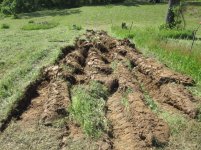OP
FrankNOhio
New member
JC, I'm right with you on the 'organic' route. Locals think I'm nuts. Anyway, I haven't studied so hard since high school. :confused2:
Starting with a self sufficient kitchen garden, then expanding to the berries and vineyard in hopes of little extra walkin' money.
On the weed control, an old tymer I visited a while back had gone around to various carpet stores and asked to have all their scraped carpeting (odds and ends from carpet orders). He put all those scraps down around the base of his grapevines and rasberries to keep the weeds down. Water apparently was able to seep through enough to keep the vines happy. His vineyard looked like a big quilt sewn together by drunkards, but he made some fine wine.
This same old guy used gravel as his mulch around all his fruit trees, 2 feet deep in a 5 foot diameter circle around the base of each tree.
Many things still to learn...
Starting with a self sufficient kitchen garden, then expanding to the berries and vineyard in hopes of little extra walkin' money.
On the weed control, an old tymer I visited a while back had gone around to various carpet stores and asked to have all their scraped carpeting (odds and ends from carpet orders). He put all those scraps down around the base of his grapevines and rasberries to keep the weeds down. Water apparently was able to seep through enough to keep the vines happy. His vineyard looked like a big quilt sewn together by drunkards, but he made some fine wine.
This same old guy used gravel as his mulch around all his fruit trees, 2 feet deep in a 5 foot diameter circle around the base of each tree.
Many things still to learn...


